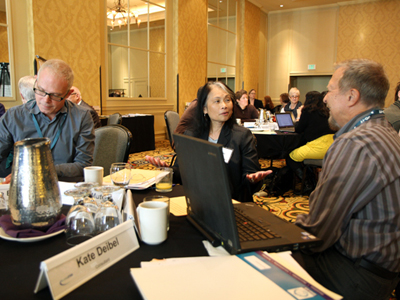Reports from Working Groups

What are examples of interventions that can promote participation and success of students with sensory impairments studying STEM?
- Teach students to self-advocate. For K-12, students may have IEPs, parent assistance, and structure that is unavailable in college.
- Separate technically easy problems, like captioning, from difficult problems like database diagramming. The former requires organizational and behavioral interventions; the latter, new technical developments.
- Revisit assumptions about literacy.
- Consider human-computer interaction tools.
- Upgrade classroom supports. Move lectures to captioned video to make them more accessible for students who are sensory impaired. Use in-class discussion as a way to encourage engagement between students with disabilities and students without disabilities.
- Use STEM-trained interpreters.
- Caption lectures with headlines outlined in the transcript (making the structure similar to that of a textbook). Create scaffolds for captioned content.
- Pair students who use similar technologies for mentoring and tutoring.
- Create an accessible science equipment lending library.
What are specific academic coaching, mentoring, and other interventions that can be employed to support students with disabilities?
- Create mentorship opportunities in many forms including group, individual, and e-mentoring by peers, students, educators, and faculty.
- Consider mentors who may or may not have disabilities, but can still be strong advocates. Consider the benefits of matching by gender.
- Tell personal stories. Building a rapport with one student can lead to building community and culture.
- Find mentors based on specific criteria, for example, at FabFems.org.
- Engage in socio-emotional advising.
- Make efforts to increase student engagement with peers. Provide transportation assistance.
- Create a mentoring group using social media such as Facebook, Twitter, Instagram, and Pinterest.
- Connect with students using identitiy development models, career coaching based on the student strengths, and industry connections related to the student goals.
- Suggest a thought-provoking media series for students to review, such as a three to five episode series on YouTube.
- Consider ways to reach postsecondary students who do not self-disclose.
- Offer a summer bridge program.
How can postsecondary faculty and other stakeholders promote the STEM success of students with disabilities using universal design (UD) and other strategies?
- Establish a faculty council with a mission of inclusion.
- Consider the identity issues of veterans, their disincentives to participate, and how universal design can address their needs.
- Employ accessibility liasons to support faculty.
- Introduce UD as part of new faculty training. Include how to adapt instruction for specific disabilities. Create models for how to implement UD, including easy to understand examples.
- Include accessible designs in technology contracts as the contractor’s responsibility.
- Promote faculty, staff, and student learning communities to discuss IT applications for life beyond the classroom.
- Widely distribute ways to make the web more accessible, like those included in AccessComputing’s 30 Web Accessibility Tips.
- Encourage campus accessibility champions to spread the word. Get testimonials from both students with disabilities and those without, and make successful outcomes more visible to faculty.
How can K-12 educators and other stakeholders employ UD or other K-12 interventions to facilitate interest and success in STEM education for students with disabilities?
- Start outreach early, like NCWIT’s AspireIT Middle School Outreach Program.
- Design professional development days and courses using UD.
- Offer informal education experiences like after school programs and conversations with youth development professionals to avoid challenges that may arise in formal settings.
- Partner with organizations which have both resources and a common interest in increasing diversity, such as GMSP, NCWIT, or Georiga Tech.
- Open lines of communication between postsecondary disabled student services offices to high school special education directors and teachers.
- Try engaging through the virtual online community Second Life. The initial benefit may be for students with social or behavioral challenges, but it can be useful for everyone.
- Accommodate different learning styles and technology so students get a strong foundation in STEM, then expose them to fun science to see where their interests lie.
- Provide opportunities for parents to learn how to encourage STEM at home, including a learning community for parents.
- Teach all students about assistive technology and software. Create opportunities for students who use assistive technology to be teaching assistants in K-12 schools.
- Provide opportunities for K-12 educators to learn about UD, accommodations, and assistive technology for credit.
- Set a goal for every student to have a positive STEM experience in elementary school.
- Look at K-12 programs like Project Lead the Way and talk with the teachers involved.
- Use images in materials that reinforce an “I can” attitude and depict a diverse student population.
What kind of supports for K-12 to college, two-year to four-year, and military to civilian transitions might maximize the success of students with disabilities in STEM?
- Secure funding that supports the replication of successful practices, not just the development of a shiny new program.
- Offer programs which provide services and supports without requiring formal “enrollment” or labeling. For veterans, there are specific issues around disability terms that can be stigmatizing or misenterpreted.
- Offer mentorship programs for campus veterans like the Virginia Commonwealth University V.E.T.S. in College program.
- Provide professional development for K-12 high school counselors. Build stronger professional collaborations with high school counselor groups.
- Deliver training in self-advocacy skills, including time management, in multiple communication formats.
What technology/science equipment strategies have the potential to promote the success of students with disabilities?
- Promote a positive job outlook in STEM fields.
- Make accessible science equipment “standard” in all classrooms and labs, starting in K-12. Widely distribute resources about accessible science equipment and labs.
- As Everett Rodgers points out, people won’t accept innovation unless the innovation fills a need. In education settings, the “need” should be apparent to both the student and the instructor.
- Design low-tech options using everyday and common materials, thereby making accommodations less “special.”
- Teach web design, coding skills, and plug-in modules using UD.